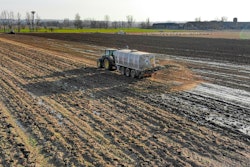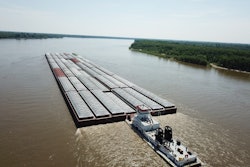
U.S. soybean exports are trailing their normal autumn pace despite rising supplies from an accelerating harvest, as low river levels have slowed the flow of grain barges to export terminals, according to U.S. Department of Agriculture (USDA) data.
Corn exports are also lagging their typical harvest-time rate, weekly USDA export inspections data showed.
According to the USDA data:
- 1.882 million tonnes of soybeans were inspected for export in the week ended October 6, up from 976,877 tonnes the prior week but below the 2.451 million tonnes inspected in the same week last year
- Corn inspections totaled just 448,423 tonnes last week, compared with 1.049 million last year; season-to-date inspections were down 21%
Low water levels hinder barge movements
Limited rains across the Midwest and South have dropped the water level on the Mississippi River to levels too shallow for many barges to effectively navigate.
This has slowed the delivery of grain barges to export terminals along the Gulf Coast, where some 60% of U.S. crop exports exit the country, reports Reuters.
Shippers have reduced barge tows by nearly 40% and cut the amount of grain loaded in each barge to prevent groundings in drought-parched waterways.
Barge spot rates drop sharply despite challenges
For the week of October 18, the St. Louis barge spot rate fell precipitously to $72.58/ton from its peak of $105.85/ton for the week of October 11, according to USDA's latest Grain Transportation Report (GTR).
Amid uncertainty about when barge traffic will normalize, some grain shippers have delayed deliveries until later in the year, which has softened demand for barges.
Nonetheless, the spot rate remains up 130% from last year and up 260% from the 3-year average.
Although spot rates have fallen, water levels on the Lower Mississippi River (LMR) continue to be an issue, with the river gauge at Memphis dropping to a record low of 10.76 feet below sea level on October 18.
On the Ohio River (which feeds a significant portion of the LMR’s water), low water levels have delayed barge traffic because of groundings and closures for dredging work.
Periodic closures for dredging, as well as tow and draft restrictions, are expected to persist at least through October based on forecast precipitation.
Rail strike threat continues to loom
News of a potential rail strike came and went in September, after President Biden announced a deal to avert a walkout.
But weeks later, one of the dozen unions representing rail workers, the Brotherhood of Maintenance of Way Employes Division (BMWED), voted against the agreement, saying it didn’t provide enough sick time nor improve working conditions.
"Railroaders are discouraged and upset with working conditions and compensation and hold their employer in low regard," said BMWED President Tony D. Cardwell in a statement.
"Railroaders do not feel valued. The result of this vote indicates that there is a lot of work to do to establish goodwill and improve the morale that has been broken by the railroads’ executives and Wall Street hedge fund managers.”
November could be critical as unions representing engineers and conductors vote on a contract. If even one union does not reach a labor agreement, it is possible that all 12 unions will strike in solidarity.
To date, four of the 11 other railroad worker unions have voted in favor of ratification with narrow vote margins. Seven unions have yet to vote.
If a deal is not ratified by all 12 unions, per the tentative agreement reached in September, Congress will be provided a window to act and prevent a potential stoppage.
Rail service issues continue
Throughout 2022, agricultural shippers have dealt with significantly deteriorated rail service and it seems it may be continuing into harvest.
USDA's GTR notes as of October 12, grain origin dwell times were down 43% from its peak in mid-May.
Despite the progress seen this year, however, a number of service metrics are still worse than prior years.
Even after dropping significantly from their peak levels earlier in the year, origin dwell times were still up 35% (as of October 12) from the same
time last year and up 23% from the 2018-21 average.
According to a report at Brownfield Ag News, Western Indiana farmer Kevin Cox says ongoing rail issues are causing unexpected grain elevator delays this harvest season.
“The elevators are having a problem getting trains in,” Cox told Brownfield. “We’ve experienced some five- and six-hour delays sitting in line at the elevator, or elevators closing because they are full.”
According to the American Farm Bureau Federation (AFBF), total grain rail cars loaded and billed dropped in the third quarter of 2022 from 398,000 cars in quarter two to 351,000 cars in quarter three.
This 47,000-car difference, though drastic, is about half the drop that occurred between quarter two 2021 and quarter three 2021, when only 295,000 cars were loaded.
In other words, railways loaded and billed fewer grain cars than last quarter but more grain cars than this time last year.
Burlington Northern and Santa Fe Railway (BNSF) and Union Pacific Railroad (UP), railroads that together processed 60% of all grain rail cars in quarter three 2022, shipped 14% and 5% fewer grain rail cars than last quarter, respectively.
Unfilled grain car orders
According to USDA's GTR, unfilled grain car orders were down significantly from their peak in late June, but were still up 413% from the same time last year and up 310% from the 2018-21 average. Unfilled grain car orders is a metric that tracks grain cars not effectively loaded and billed.
AFBF noted a look at cumulative weekly unfilled grain car orders reveals these declines are still not due to reduced demand from shippers.
Between the second quarter of 2022 and third quarter of 2022, the number of these cumulative unfilled orders dropped from 204,000 to 104,000 – a 48% decrease.
BNSF saw an 81% drop in cumulative unfilled orders over last quarter from 131,000 to 24,452. In weekly metrics this translates to a drop from 10,086 average unfilled orders per week to 1,880.
UP numbers are not as positive, showing an increase of 19,385 (55,000 to 74,000), or 35%, in cumulative unfilled orders between the second and third quarters of 2022. In weekly metrics this translates to an increase from 4,264 average unfilled orders per week to 5,755.
Year-over-year, however, cumulative weekly unfilled grain car orders between quarter three of 2021 and quarter three of 2022 are up over 1,200%
All the railroads named a labor shortage as the primary cause of the ongoing disruptions. During the pandemic, many railroads accelerated labor force cuts in the wake of low demand during early 2020. When demand returned, a tight labor market complicated the hiring of new employees.
For the week ending October 13, bids for delivery of shuttle railcars in November averaged $1,700, up $1,400 from the average of the same week in 2019-21. These high bids for rail cars suggest shippers are still concerned about rail service in the coming months says the GTR.
Diesel price rises for second time since June
After reaching record levels in June, the GTR notes diesel prices rose again by 38.8 cents/gallon during the week ending October 10.
This increase followed the decision by OPEC+ (OPEC and non-OPEC allies) on October 5 to reduce oil production by 2 million barrels per day starting in November.
Following OPEC + decision, the Department of Energy is expected to issue another 10 million barrels from the Strategic Petroleum Reserve to the market in November, extending the historic releases President Biden ordered in March.
For the week ending October 17, the national average diesel price increased by another 11.5 cents/gallon to $5.339/gallon, $1.668 above the same price last year
Continuing rail service disruptions from labor shortages, rail car inventory and capacity constraints, a potential rail strike layered with barge issues and high diesel prices will continue to hinder the grain supply chain this harvest season.

















